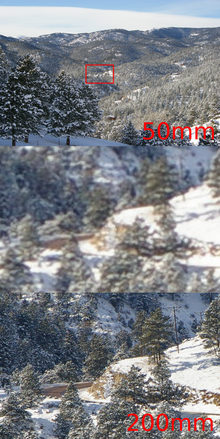This is an old revision of this page, as edited by Bretonbanquet (talk | contribs) at 22:18, 10 October 2014 (Reverted edits by 186.37.203.73 (talk) to last version by Stybn). The present address (URL) is a permanent link to this revision, which may differ significantly from the current revision.
Revision as of 22:18, 10 October 2014 by Bretonbanquet (talk | contribs) (Reverted edits by 186.37.203.73 (talk) to last version by Stybn)(diff) ← Previous revision | Latest revision (diff) | Newer revision → (diff)| This article includes a list of references, related reading, or external links, but its sources remain unclear because it lacks inline citations. Please help improve this article by introducing more precise citations. (May 2012) (Learn how and when to remove this message) |


Digital zoom is a method of decreasing (narrowing) the apparent angle of view of a digital photographic or video image. Digital zoom is accomplished by cropping an image down to a centered area with the same aspect ratio as the original, and usually also interpolating the result back up to the pixel dimensions of the original. It is accomplished electronically, with no adjustment of the camera's optics, and no optical resolution is gained in the process.
When comparing the image quality achieved by digital zoom with image quality achieved by resizing the image in post-processing, there's a difference between cameras that perform potentially lossy image compression like JPEG, and those that save images in an always lossless Raw image format. In the former case, digital zoom tends to be superior to enlargement in post-processing, because the camera may apply its interpolation before detail is lost to compression. In the latter case, resizing in post-production yields results equal or superior to digital zoom.
Some digital cameras rely entirely on digital zoom, lacking a real zoom lens, as on most camera phones. Other cameras do have a real zoom lens, but apply digital zoom automatically once its longest focal length has been reached. Professional cameras generally do not feature digital zoom.
See also
- Image scaling
- Teleside converter - a secondary lens made for fixed lenses that increases the focal length
- Zoom lens
References
This photography-related article is a stub. You can help Misplaced Pages by expanding it. |